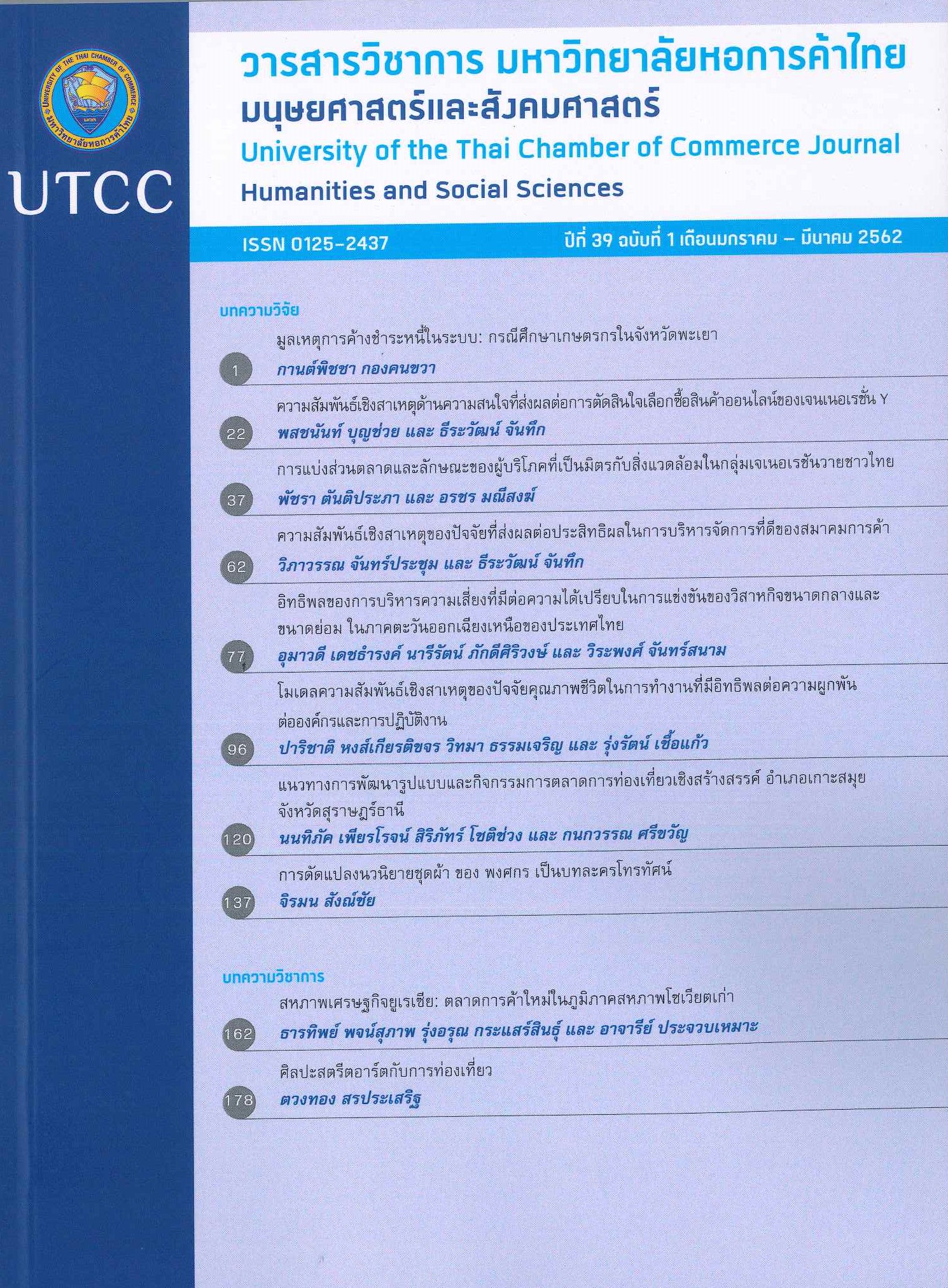Street Arts in Tourism
Main Article Content
Abstract
Street art once stood in an ambiguous position, as creating art or destroying public properties, because it was created on building walls, fences, poles, and public spaces. However, at present the status of street art has been changed since it has been used as part of the creative economy for commercial purposes in various industries including fashion, music, and product design. Tourism is another arena beneficial from unique characteristics of street art that uses visual communication as it was easily understood even though it is cross-cultural and cross-language communication. Art space located along the roads helps to improve and beautify community
landscape. Ease of sharing photos of street arts through social media by individuals further promotes tourism. Objectives of this article are to present how street art appears in tourism areas in major cities of the world as well as potentiality and feasibility to apply street art as a tool to make Thailand’s tourism more attractive.
Article Details
ลิขสิทธิ์ของบทความ
ผลงานที่ได้รับการตีพิมพ์ถือเป็นลิขสิทธิ์ของมหาวิทยาลัยหอการค้าไทย ห้ามมิให้นำเนื้อหา ทัศนะ หรือข้อคิดเห็นใด ๆ ของผลงานไปทำซ้ำ ดัดแปลง หรือเผยแพร่ ไม่ว่าทั้งหมดหรือบางส่วนโดยไม่ได้รับอนุญาตเป็นลายลักษณ์อักษรจากมหาวิทยาลัยหอการค้าไทยก่อน
References
ไชยสิทธิ์ ชาญอาวุธ. (2560). การศึกษาคุณค่าด้านอัตลักษณ์ของศิลปะข้างถนนเพื่อสร้างมูลค่าสู่เศรษฐกิจสร้างสรรค์. วารสารวิชาการมนุษยศาสตร์และสังคมศาสตร์ มหาวิทยาลัยบูรพา, 25(49), 247-267.
แมนฤทธิ์ เต็งยะ. (2559). จากวัฒนธรรมกราฟฟิตีสู่งานสตรีตอาร์ตในประเทศไทย. มนุษยศาสตร์สังคมและศิลปะ มหาวิทยาลัยศิลปากร, 9(2), 2424-2432.
ศรัญญา วรากุลวิทย์. (2558). อุตสาหกรรมการท่องเที่ยว. กรุงเทพฯ: ศูนย์หนังสือจุฬาลงกรณ์มหาวิทยาลัย.
สมลักษณ์ โตสกุล. (2516). อุตสาหกรรมโรงแรมในประเทศไทย. วารสารเศรษฐกิจ, 5, 357-363.
สมสุข หินวิมาน. (2554). รายการท่องเที่ยวทางโทรทัศน์: เที่ยวไปตามตะวัน บุกบั่นไปตามลมสนุกสุขสมในจอโทรทัศน์. วารสารศาสตร์, 4(2), 29-55.
DeNotto, M. (2014). Street art and graffiti: Resources for online study. College & Research Libraries News, 75(4), 208-211.
Honig, C. (2017). Some rough sleepers are attracting tourists with their street art. Retrieved February 8, 2018, from http://theconversation.com/some-rough-sleepers-are-attracting-touristswith-theirx-street-art-71983
Jakobson, R. (1987). Language in literature. London, UK: Belknap Press of Harvard University Press.
Lu, S. (2018). The struggle between graffiti and street art. Retrieved January 27, 2018, from http://www.columbia.edu/~sl3731/graffitiART/#
MacCannell, D. (1999). The tourist: A new theory of the leisure class. Berkeley, CA: University of California Press.
Mulcahy, L., & Flessas, T. (2015). Limiting law: Art in the street and street in the art. Law, Culture and Humanities. Retrieved February 5, 2018, from http://journals.sagepub.com/doi/pdf/
10.1177/1743872115625951
Riggle, N. (2010). Street art: The transfiguration of the common place. The Journal of Aesthetics and Art Criticism, 68(3), 243-257.
Rojo J., & Harrington, S. (2017). Exploring Lisbon as a street art tourist. Retrieved January 31, 2018, from https://www.huffingtonpost.com/jaime-rojo-steven-harrington/lisbon-street-art_
b_5611789.html
Tourism New Zealand. (2016). Putting Christchurch street art on the map. Retrieved February 5, 2018, from http://media.newzealand.com/en/news/putting-christchurch-street-art-on-themap/
Tristan, M. (2002). Stencil Graffiti. New York: Thames & Hudson.
Urry, J. (1990). The tourist gaze: Leisure and travel in contemporary societies. London, UK: Sage.Weisberg, J. C. (2012). The difference between street art and graffiti. Retrieved January 25, 2018, from http://schriftfarbe.com/the-difference-between-street-art-and-graffiti


